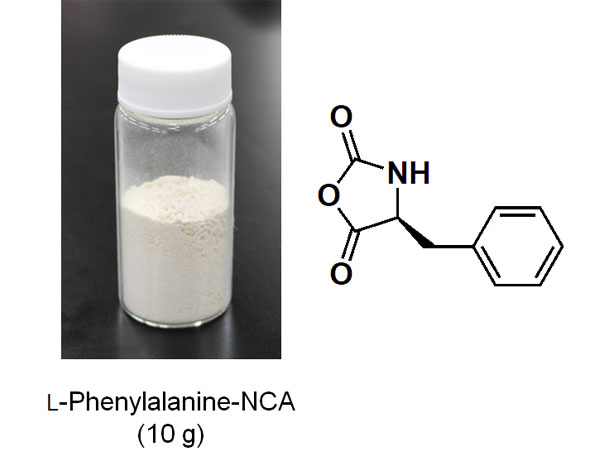
In nature, there are animals that make fibers which are strong and elastic. For example, the thread that spiders produce to make webs. These fibers have a polypeptide structure and serve as inspiration for research into the development of functional materials. Alpha (α)-amino acid N-Carboxyanhydrides (NCAs) are precursors for artificial polypeptides. However, this compound decomposes easily, making it difficult to obtain commercially. Therefore, it is necessary to synthesize the right quantity of α-amino acid NCAs at the location and time that they are required. NCAs are usually synthesized from plant-derived amino acids and phosgene. However, phosgene is extremely toxic and dangerous to use, leading to growing demand for new chemical compounds and reactions that can be substituted for it. Using the photo-on-demand phosgenation method that they previously developed, Associate Professor TSUDA Akihiko's research group at Kobe University's Graduate School of Science has succeeded in synthesizing NCA in a safe, inexpensive and simple manner from chloroform (a common organic solvent) and amino acid.
Patents were filed in relation to this study in November 2018 and November 2019. The academic paper was published online in ACS Omega on October 19, 2022.
Main points
- Safe on-site and on-demand synthesis of polypeptide precursors (NCAs) using light.
- The research group succeeded in synthesizing 11 types of NCA from chloroform (a common organic solvent) and commercial amino acid.
- In the laboratory, they managed to synthesize these substances on a scale up to ten grams (and this can be scaled up to for production on a kilogram scale)
- Compared to the conventional synthesis method (using phosgene) and phosgene substitution methods, the raw materials are less expensive, the work involved is easier and less waste is generated. This could reduce costs as well as the burden on the environment.
- The reaction is promoted by visible light, and it is theoretically possible to perform this synthesis reaction using sunlight
- These research results will accelerate industry/academia's development of bio-derived functional polypeptides.
- It is hoped that these methods will become established techniques that will contribute greatly towards the SDGs and efforts to become carbon neutral.
Research Background
Phosgene (COCl2) is used as precursor for polymers and as a pharmaceutical intermediate. The global phosgene market continues to grow by several percent each year, with around 8 to 9 million tonnes produced annually. However, phosgene is extremely toxic. For safety reasons, research and development is being conducted to find alternatives. In a world-first discovery, Associate Professor Tsuda's research group irradiated chloroform with ultraviolet light, which caused it to react with oxygen and generate high yields of phosgene (patent no. 5900920). In order to do this in an even safer and easier manner, the research group found a way that the phosgene-generating reactions could be instantly performed. They first dissolved the reactants and catalysts in chloroform, and generated phosgene by irradiating the solution with light (patent no. 6057449). In this way, phosgene-based organic synthesis can be carried out as if phosgene wasn't used.
The research group has named their discovery 'photo on demand organic synthesis method' and have successfully used it to synthesize numerous useful organic chemicals and polymers (list of patents (in Japanese): Patents of Tsuda Laboratory






